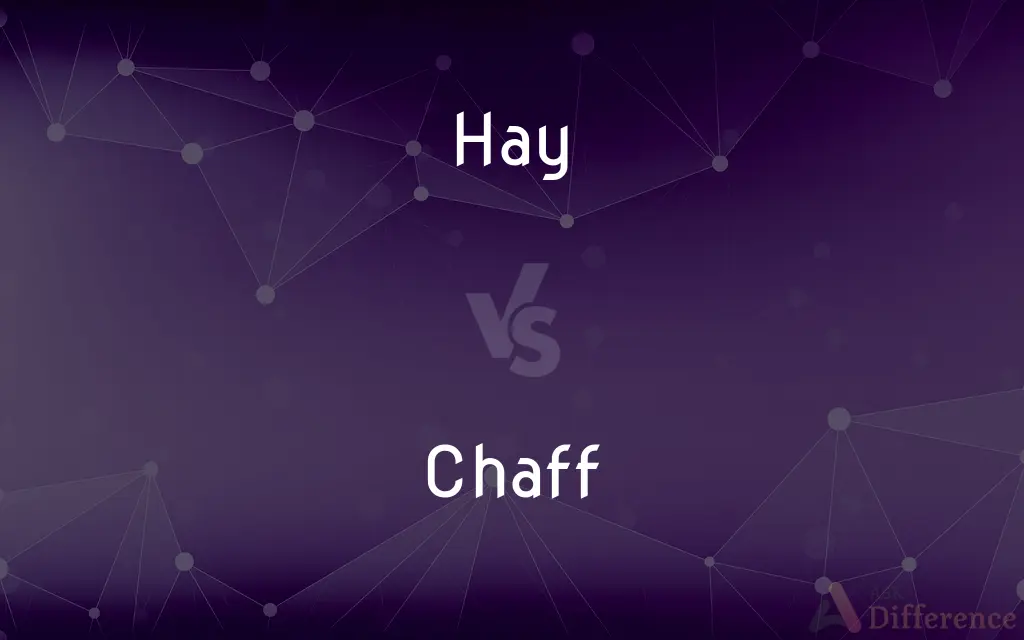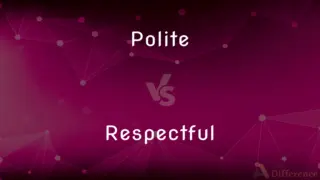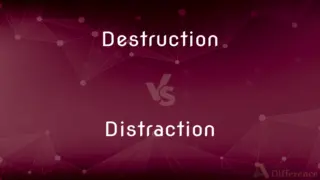Hay vs. Chaff — What's the Difference?
Edited by Tayyaba Rehman — By Maham Liaqat — Updated on April 16, 2024
Hay is dried grass used mainly as animal fodder, while chaff refers to the husks separated from grains during threshing.

Difference Between Hay and Chaff
Table of Contents
ADVERTISEMENT
Key Differences
Hay consists primarily of grass that has been cut and dried to be used as animal feed, particularly for grazing animals like cows and horses. Whereas, chaff is the dry, scaly protective casings of the seeds of cereal grain, or similar fine particles from other materials like hay.
When harvesting cereal crops, hay is not typically a byproduct; it is the main product, harvested specifically for its nutritional value to livestock. On the other hand, chaff is a byproduct of harvesting cereals, consisting of parts of the plant that are not edible.
Hay is stored and preserved to provide feed for livestock throughout the year, especially in winter when fresh grass is scarce. Chaff, however, has little nutritional value and is often discarded, used as bedding for animals, or utilized in composting.
The preparation of hay involves cutting, drying, and baling grasses and other herbaceous plants. Chaff, in contrast, is separated from grains during the threshing process and is typically handled as waste unless repurposed.
In terms of usability, hay is crucial for agriculture, especially in temperate regions, providing a stable source of nutrition for herbivorous farm animals. Chaff plays a minimal role in direct animal nutrition but can be used in agricultural practices to enhance soil organic matter or as mulch.
ADVERTISEMENT
Comparison Chart
Definition
Dried grass and plants used as animal fodder
Husks of grains separated during threshing
Primary Use
Animal feed
Waste byproduct or used for mulching
Nutritional Value
High, provides essential nutrients
Low, mostly inedible
Preparation
Cut, dried, and baled
Separated during threshing and discarded
Agricultural Role
Essential for livestock nutrition
Minor, used in composting or as mulch
Compare with Definitions
Hay
Usually involves processes like cutting, drying, and baling.
The hay was baled last week just before the rain started.
Chaff
Often regarded as a waste product in grain production.
We collect chaff to use as a bedding material for the livestock.
Hay
A harvested product primarily used in agriculture.
Quality hay is essential for maintaining healthy dairy cows.
Chaff
Has minimal direct use in animal feed.
Unlike hay, chaff is not suitable for feeding our horses.
Hay
Serves as a crucial feed during colder months when pasture is unavailable.
The sheep rely heavily on hay during the snowy season.
Chaff
Primarily composed of inedible parts of grain crops.
Chaff is mostly cellulose, which has little nutritional value.
Hay
Dried grasses or other herbaceous plants used as feed for livestock.
Farmers store hay in barns to feed their cattle during the winter months.
Chaff
Used occasionally in gardening and composting.
Chaff can help improve soil structure when added to compost.
Hay
Rich in nutrients, making it a valuable dietary component for herbivores.
The new batch of hay is exceptionally rich in proteins and fibers.
Chaff
The husks of cereals and legumes separated during threshing.
The wheat chaff was blown away by the wind at the threshing site.
Hay
Hay is grass, legumes, or other herbaceous plants that have been cut and dried to be stored for use as animal fodder, particularly for large grazing animals raised as livestock, such as cattle, horses, goats, and sheep. However, it is also fed to smaller domesticated animals such as rabbits and guinea pigs.
Chaff
Chaff (; also UK: ) is the dry, scaly protective casing of the seeds of cereal grains, or similar fine, dry, scaly plant material such as scaly parts of flowers, or finely chopped straw. Chaff is indigestible by humans, but livestock can eat it and in agriculture it is used as livestock fodder, or is a waste material ploughed into the soil or burned.
Hay
Grass or other plants, such as clover or alfalfa, cut and dried for fodder.
Chaff
The dry bracts enclosing mature grains of wheat and some other cereal grasses, removed during threshing.
Hay
(Slang) A trifling amount of money
Gets $100 an hour, which isn't hay.
Chaff
The scales or bracts borne on the receptacle among the small individual flowers of many plants in the composite family.
Hay
To mow and cure grass and herbage for hay.
Chaff
Finely cut straw or hay used as fodder.
Hay
To make hay on (a patch of land).
Chaff
Trivial or worthless matter
Ignored the picky, unimportant criticisms that were just a lot of chaff.
Hay
To make (grass or other plants) into hay.
Chaff
Strips of metal, foil, or glass fiber with a metal content, cut into various lengths and having varying frequency responses, that are used to reflect electromagnetic energy as a radar countermeasure. These materials, usually dropped from aircraft, also can be deployed from shells or rockets.
Hay
To feed with hay.
Chaff
Good-natured teasing; banter.
Hay
(uncountable) Grass cut and dried for use as animal fodder.
Chaff
To make fun of in a good-natured way; tease
Chaffed him for forgetting the appointment.
Hay
(countable) Any mix of green leafy plants used for fodder.
Chaff
To engage in playful teasing.
Hay
(slang) Cannabis; marijuana.
Chaff
The inedible parts of a grain-producing plant.
To separate out the chaff, early cultures tossed baskets of grain into the air and let the wind blow away the lighter chaff.
Hay
A net set around the haunt of an animal, especially a rabbit.
Chaff
Straw or hay cut up fine for the food of cattle.
Hay
(obsolete) A hedge.
Chaff
(figurative) Any excess or unwanted material, resource, or person; anything worthless.
Hay
(obsolete) A net placed around the lair or burrow of an animal.
Chaff
Light jesting talk; banter; raillery.
Hay
(obsolete) An enclosure, haw.
Chaff
(military) Loose material, e.g. small strips of aluminum foil dropped from aircraft, intended to interfere with radar detection.
Hay
(obsolete) A circular country dance.
Chaff
(intransitive) To use light, idle language by way of fun or ridicule; to banter.
Hay
The letter for the h sound in Pitman shorthand.
Chaff
(transitive) To make fun of; to turn into ridicule by addressing in ironical or bantering language; to quiz.
Hay
To cut grasses or herb plants for use as animal fodder.
Chaff
(transitive) To cut up (straw or hay) for use as cattle feed.
Hay
To lay snares for rabbits.
Chaff
The glumes or husks of grains and grasses separated from the seed by threshing and winnowing, etc.
So take the corn and leave the chaff behind.
Old birds are not caught with caff.
Hay
A hedge.
Chaff
Anything of a comparatively light and worthless character; the refuse part of anything.
The chaff and ruin of the times.
Hay
A net set around the haunt of an animal, especially of a rabbit.
Chaff
Straw or hay cut up fine for the food of cattle.
By adding chaff to his corn, the horse must take more time to eat it. In this way chaff is very useful.
Hay
Grass cut and cured for fodder.
Make hay while the sun shines.
Hay may be dried too much as well as too little.
Chaff
Light jesting talk; banter; raillery.
Hay
To lay snares for rabbits.
Chaff
The scales or bracts on the receptacle, which subtend each flower in the heads of many Compositæ, as the sunflower.
Hay
To cut and cure grass for hay.
Chaff
To use light, idle language by way of fun or ridicule; to banter.
Hay
Grass mowed and cured for use as fodder
Chaff
To make fun of; to turn into ridicule by addressing in ironical or bantering language; to quiz.
Morgan saw that his master was chaffing him.
A dozen honest fellows . . . chaffed each other about their sweethearts.
Chaff
Material consisting of seed coverings and small pieces of stem or leaves that have been separated from the seeds
Chaff
Foil in thin strips; ejected into the air as a radar countermeasure
Chaff
Be silly or tease one another;
After we relaxed, we just kidded around
Common Curiosities
What is chaff made of?
Chaff consists of the husks of grains and other fine particulate material separated during threshing.
Can chaff be used for anything?
Yes, chaff can be used for composting, mulching, or as bedding for animals.
What is hay used for?
Hay is primarily used as feed for livestock.
Is chaff edible?
No, chaff is generally inedible and is considered agricultural waste.
Why is hay important for farmers?
Hay is crucial for feeding livestock, especially during periods when pasture is not available.
How do farmers handle excess chaff?
Excess chaff is often disposed of or used in compost heaps.
Does chaff have any nutritional value?
Chaff has minimal nutritional value and is not used as animal feed.
Is hay production seasonal?
Yes, hay production is typically seasonal, aligned with the growth cycles of grasses and other plants.
How is hay produced?
Hay production involves cutting, drying, and baling grasses.
Can chaff be recycled?
Yes, chaff can be recycled in various ways such as in composting or as a mulching material.
What types of plants are used to make hay?
Common plants used for hay include grasses, clover, and alfalfa.
How is chaff separated from grain?
Chaff is separated from grain through a process called threshing.
What happens to chaff during the milling process?
During milling, chaff is usually separated and removed from the grain.
Can hay be used for purposes other than feeding animals?
While primarily used for feeding animals, hay can also be used for bedding and erosion control.
Is hay good for all farm animals?
Hay is beneficial for many farm animals, particularly ruminants like cows and sheep.
Share Your Discovery

Previous Comparison
Polite vs. Respectful
Next Comparison
Destruction vs. DistractionAuthor Spotlight
Written by
Maham LiaqatEdited by
Tayyaba RehmanTayyaba Rehman is a distinguished writer, currently serving as a primary contributor to askdifference.com. As a researcher in semantics and etymology, Tayyaba's passion for the complexity of languages and their distinctions has found a perfect home on the platform. Tayyaba delves into the intricacies of language, distinguishing between commonly confused words and phrases, thereby providing clarity for readers worldwide.
















































